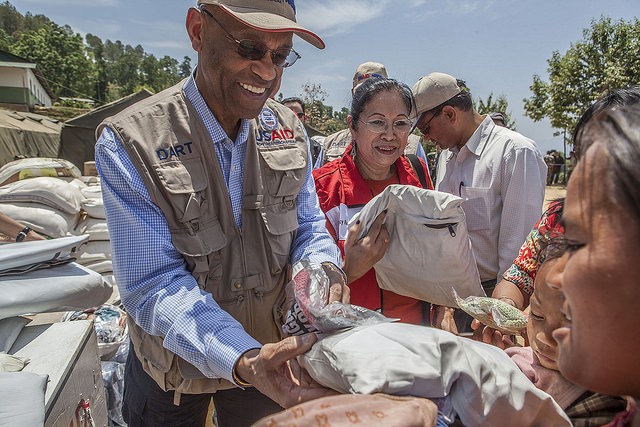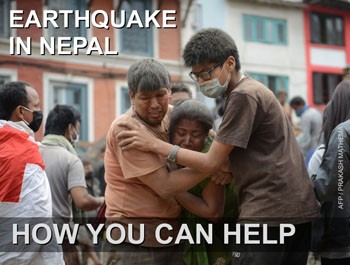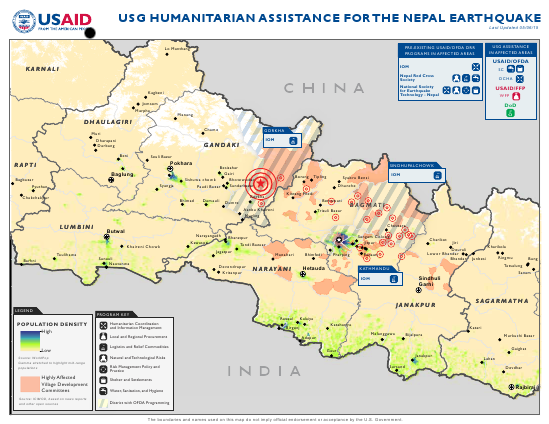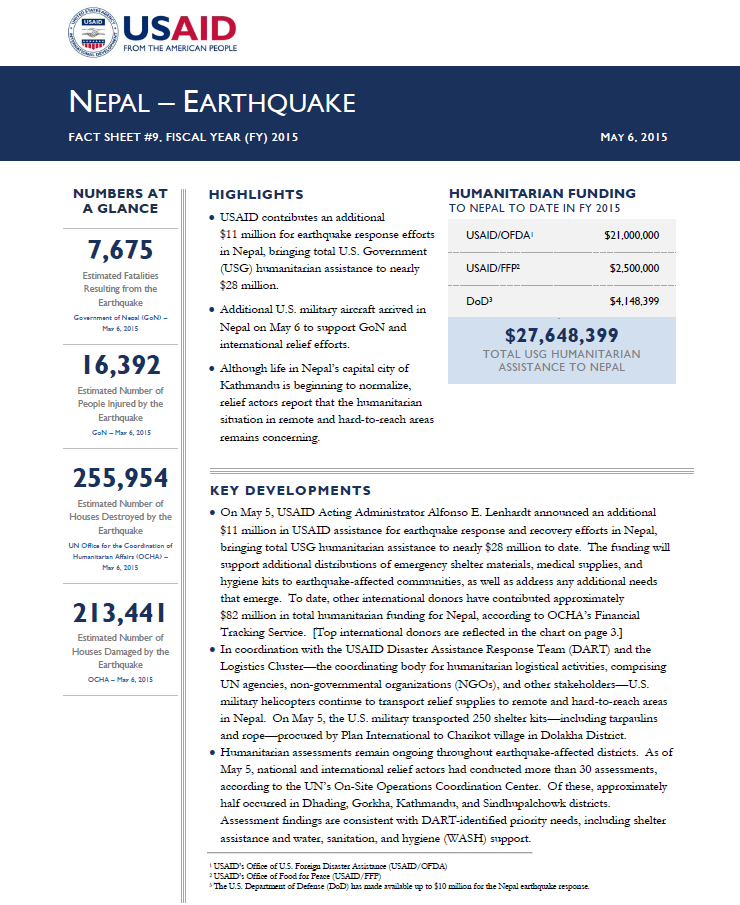Speeches Shim
May 6, 2015
Highlights
USAID contributes an additional $11 million for earthquake response efforts in Nepal, bringing total U.S. Government (USG) humanitarian assistance to nearly $28 million.
Additional U.S. military aircraft arrived in Nepal on May 6 to support GoN and international relief efforts.
Although life in Nepal’s capital city of Kathmandu is beginning to normalize, relief actors report that the humanitarian situation in remote and hard-to-reach areas remains concerning.
Key Developments
Nepal Earthquake Map - May 6, 2015 ![]() (pdf - 890k)
(pdf - 890k)
Numbers At A Glance
7,675
16,392
255,954
213,441
Humanitarian Funding:
To Nepal To Date In FY2015:
| USAID/OFDA | $21,000,000 |
| USAID/FFP | $2,500,000 |
| DoD | $4,148,399 |
| TOTAL | $27,648,399 |
Nepal Earthquake Fact Sheet #9 - 05-06-2015 ![]() (pdf - 194k)
(pdf - 194k)
On May 5, USAID Acting Administrator Alfonso E. Lenhardt announced an additional $11 million in USAID assistance for earthquake response and recovery efforts in Nepal, bringing total USG humanitarian assistance to nearly $28 million to date. The funding will support additional distributions of emergency shelter materials, medical supplies, and hygiene kits to earthquake-affected communities, as well as address any additional needs that emerge. To date, other international donors have contributed approximately $82 million in total humanitarian funding for Nepal, according to OCHA’s Financial Tracking Service. [Top international donors are reflected in the chart on page 3.]
In coordination with the USAID Disaster Assistance Response Team (DART) and the Logistics Cluster—the coordinating body for humanitarian logistical activities, comprising UN agencies, non-governmental organizations (NGOs), and other stakeholders—U.S. military helicopters continue to transport relief supplies to remote and hard-to-reach areas in Nepal. On May 5, the U.S. military transported 250 shelter kits—including tarpaulins and rope—procured by Plan International to Charikot village in Dolakha District.
Humanitarian assessments remain ongoing throughout earthquake-affected districts. As of May 5, national and international relief actors had conducted more than 30 assessments, according to the UN’s On-Site Operations Coordination Center. Of these, approximately half occurred in Dhading, Gorkha, Kathmandu, and Sindhupalchowk districts. Assessment findings are consistent with DART-identified priority needs, including shelter assistance and water, sanitation, and hygiene (WASH) support.
HUMANITARIAN ASSESSMENTS
Relief actors have conducted more than 30 humanitarian assessments across 16 districts since the April 25 earthquake, according to the UN. Efforts to assess damages and priority needs will continue as access to rural and hard-to-reach communities improves.
With authorization from Nuwakot’s District Disaster Response Committee (DDRC), Oxfam conducted assessments in Nuwakot’s Khadag Bhanjyang, Madanpur, and Thaprek village development committees (VDCs), identifying shelter and WASH as the two most urgent needs. Oxfam’s assessments reveal that the earthquake destroyed approximately 80 to 90 percent of traditional brick or stone buildings in assessed VDCs, as well as 80 to 90 percent of grain storage and animal sheds.
The assessments found few damaged water points, and populations residing in these VDCs appear to have adequate access to water through nearby springs and streams. However, many interviewed households have lost containers used to safely carry and store water. In addition, the earthquake destroyed approximately 75 percent of latrines in assessed VDCs, forcing many people to defecate in open areas and subsequently increasing the potential for contaminated water supply and related public health risks.
Consistent with assessments from Nuwakot and other districts, a recent assessment of Bhaktapur District—one of the three districts in Kathmandu Valley—by a Government of Canada (GoC) humanitarian team identified critical shelter and WASH needs. According to the assessment, approximately 50–70 percent of buildings in Bhaktapur are presently uninhabitable, while 10 percent of buildings are completely destroyed. Although the team observed a prevalence of tarp-based shelters in displacement sites, populations have used tarpaulins in a manner that provides limited cover and protection from the elements, and materials such as cardboard, bricks, or mattresses are being used for flooring. These observations underscore the importance of providing comprehensive shelter assistance that includes guidance on how to appropriately use the materials to construct adequate and durable shelter, along with plastic sheeting, ropes, wire, and tools for construction.
The GoC assessment team also reported limited quantities of well and piped water available in Bhaktapur’s VDCs, with available water supplies requiring boiling before consumption. In displacement sites, residents are retrieving water by truck or motorbike; however, many lack means to store water. According to the assessment, hygiene and sanitation facilities in Bhaktapur’s displacement sites are also inadequate.
COORDINATION AND LOGISTICS SUPPORT
Humanitarian organizations continue to report challenges at Kathmandu’s Tribhuvan International Airport (TIA)—the only international air entry point into Nepal—due to the large influx of international aid following the April 25 earthquake and a shortage of available landing slots. On May 5, a U.S. Air Force Contingency Response Group (CRG) arrived in Nepal to work with the DART and the GoN to streamline airfield operations and expedite the distribution of relief supplies to communities in need. At present, the DART reports that relief items arriving at TIA are reaching consignees within 24 hours of arrival.
To reduce the amount of relief supplies routed through Kathmandu and facilitate the distribution of inbound relief commodities from India to Nepal’s Eastern and Western regions, district-level logistical hubs are being set up in Ghorka and Kavrepalanchowk districts, as well as at three points along the India-Nepal border, the Logistics Cluster reports.
As of May 4, the UN Humanitarian Air Service (UNHAS) had made available two helicopters, and announced plans to add another four helicopters to their fleet, to transport urgently needed humanitarian cargo and personnel to inaccessible and remote areas of Nepal. In addition, the UN World Food Program (WFP) recently contracted a fleet of 25 trucks to further increase transport capacity of emergency relief commodities from TIA’s humanitarian staging area to affected communities.

RELIEF COMMODITIES AND SHELTER SUPPORT
Despite continued road blockages and mountainous terrain, emergency relief commodities are beginning to reach critical areas identified by the GoN. In coordination with Nepalese DDRCs and WFP, USAID/Nepal partner CARE had distributed food commodities and emergency relief materials to nearly 540 earthquake-affected families in Gorkha’s Barpak and Simjung VDCs as of May 5. CARE also distributed emergency relief items—tarpaulins, blankets, floor mats, dignity kits, and water containers—to an additional 800 families in Deurali VDC, Kaski District; Dhuwakot VDC, Dhading District; and Gankhu VDC, Kathmandu District.
According to OCHA, the April 25 earthquake had damaged or destroyed more than 469,000 houses across affected areas of Nepal as of May 6. To address critical shelter needs, national and international relief actors have distributed more than 62,500 tarpaulins to earthquake-affected households in high-priority districts, the Shelter Cluster reports. Approximately 40 percent of these tarpaulins have reached Gorkha, where the earthquake destroyed an estimated 90 percent of homes.
In coordination with the DART and the Logistics Cluster, U.S. military air assets continue to transport relief supplies to affected areas of Nepal. On May 5, the U.S. military transported 250 shelter kits—including tarpaulins and rope—procured by Plan International to Charikot village. To date, Save the Children (SC) has distributed 450 rolls of USAID/OFDA-supplied plastic sheeting to communities in Gorkha, Sindhupalchowk, and Kathmandu Valley. SC has complemented distributions of shelter assistance with guidance on the appropriate use of plastic sheeting to construct adequate shelter, and SC’s community mobilizers have been available to identify additional community-sourced assistance for particularly vulnerable households.
CONTEXT
On April 25, a magnitude 7.8 earthquake struck central Nepal at a shallow depth of approximately 15 kilometers (km), according to the USGS. The epicenter of the earthquake was located approximately 77 km northwest of Kathmandu, the country’s capital city, and 73 km east of Pokhara, another major city in central Nepal.
The USG immediately issued a disaster declaration for Nepal due to the effects of the earthquake. Within hours of the seismic event, USAID/OFDA had activated a RMT in Washington, D.C., and deployed a DART—including USAR specialists—to support emergency response efforts in Nepal.
For nearly two decades, USAID/OFDA has supported disaster risk reduction (DRR) efforts in Nepal, including throughout Kathmandu Valley. USAID/OFDA funding has enabled the International Organization for Migration (IOM) to identify, prepare, and preserve more than 80 open spaces in Kathmandu Valley to ensure the sites are available for humanitarian purposes—such as distribution centers or warehouses—in the event of large-scale disasters. USAID/OFDA has also supported NRCS to pre-position critical emergency relief supplies in order to address the immediate needs of affected communities following a disaster.
Through the Kathmandu-based National Society for Earthquake Technology (NSET), USAID/OFDA is strengthening Nepal’s earthquake response capacity by institutionalizing DRR at the local and national levels in collaboration with the GoN, non-governmental organizations, schools, and local communities. With USAID/OFDA support, NSET is also promoting public-private partnerships for earthquake risk management and enhancing the capacity of municipal governments to develop and administer building code permits and control systems to better protect against seismic activity.
PUBLIC DONATION INFORMATION
The most effective way people can assist relief efforts is by making cash contributions to humanitarian organizations that are conducting relief operations. A list of humanitarian organizations that are accepting cash donations for disaster responses around the world can be found at www.interaction.org.
USAID encourages cash donations because they allow aid professionals to procure the exact items needed (often in the affected region); reduce the burden on scarce resources (such as transportation routes, staff time, and warehouse space); can be transferred very quickly and without transportation costs; support the economy of the disaster-stricken region; and ensure culturally, dietary, and environmentally appropriate assistance.
More information can be found at:
- The Center for International Disaster Information: www.cidi.org or +1.202.821.1999.
-
Information on relief activities of the humanitarian community can be found at www.reliefweb.int.




Comment
Make a general inquiry or suggest an improvement.